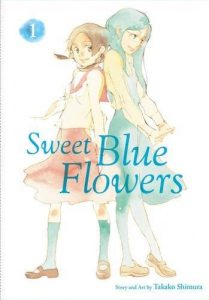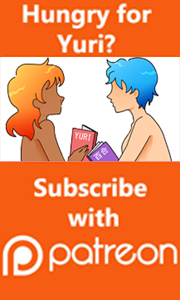 Third time’s the charm. In 2012, JManga did a digital-only translation. Towards the end of 2014, Digital Manga Publishing also tried putting Shimura Takako-sensei’s new classic Yuri manga out as a digital publication. Now, in 2017 we have what is very likely to be the definitive English-language translation for the series, in omnibus format. Thanks to Jocelyne Allen, Jen Gruningen and the folks at Viz, I think we’re at peak Aoi Hana here in the west.
Third time’s the charm. In 2012, JManga did a digital-only translation. Towards the end of 2014, Digital Manga Publishing also tried putting Shimura Takako-sensei’s new classic Yuri manga out as a digital publication. Now, in 2017 we have what is very likely to be the definitive English-language translation for the series, in omnibus format. Thanks to Jocelyne Allen, Jen Gruningen and the folks at Viz, I think we’re at peak Aoi Hana here in the west.
Sweet Blue Flowers, Volume 1 introduces us to Manjome Fumi and her old childhood friend, Okudaira Akira. They had been very close as children, but when Fumi moved, they fell out of touch. Now, as they both head to different high-end girls’ schools, they’ve met again.
I was reminded as I read this book that although the opening and the ending are – in my opinion – very weak, the rest of the story is excellent. It’s got surprising depth and breadth. Characters that surround Fumi and Akira are as well-developed as they and as interesting.
In the first half of this Volume 1 – the original Volume 1 that was, Fumi is charmed, then asked out by an upperclassman at her all-girl’s school. Sugimoto is not her first girlfriend, but may well be the first by her own volition. Their time together is brief, as it becomes very clear that Sugimoto carries a whole host of issues with her and Fumi recognizes that she’s worth paying full attention to. By the second half of the volume, Fumi has learned a lot about herself, among them that Sugimoto is the third person she’s loved.
The school play gives a chance for the cast of both schools to mix and emotions to be be heightened. Wuthering Heights is an unsurprising allegory for the tensions and passions of the cast to swirl and come together and part, like a storm.
But by the end of the volume we have Akira and Fumi still friends. Fumi has, in a very rare act in Yuri manga, comes out to Akira. It’s a tempestuous time in their lives, but they both know who each other were – and are – and are there for each other.
This still, after all these years, stands out as one of Shimura’s most tightly put-together stories. Other series have sort of swirled and eddied around the same material without changing, but we can see the changes to Akira and Fumi and their friends in pretty steady progression, as they encounter, deal with and grow from challenging situations.
This is a series that has many (if not all) the hallmarks of a “S”-era story and in my Very Brief History of Yuri I call it and Maria-sama ga Miteru “S for a new generation.” We can, like Fumi, enjoy the atmosphere of an old girl’s school. We can enjoy the drama that comes along with the hot-house environment. And we get the added advantage of characters with society – friends and families, brothers and parents and teachers who are male and female and a modern sensibility, in which gay people exist, and have lives. This is all so critical to my enjoyment of a manga. We have this series in omnibus form (available in print and digital format) and it, like several other series available right now, will be on my short-list of books that embody the classic concepts of the genre of “Yuri.”
Interestingly, since the author attempted (unsuccessfully) to visit Yoshiya Nobuko’s home, the grandmother of Yuri gets both a mention in the notes and is attributed as the women who pioneered Yuri in Japanese literature. This is true, but she’s even more important than the note accounted for, because she not only pioneered Yuri, but also a great deal of what we think of as shoujo literature and manga. Yoshiya Nobuko-sensei was the richest woman in Japan in her lifetime. She’s an inspiration and a hero of mine. (Here’s my report of visiting Yoshiya-sensei’s home, from 2013.)
This edition came with a lovely assortment of postcards from the Aoi Hana Meets the Enoshima Electric Railway collaboration event from 2012 (an event reported in excellent detail by Guest Reviewer Bruce P – with pictures!). The book itself is exceedingly well put-together, with those cover flaps that take the place of a dustcover, but allow readers to see all of the cover and flap art. Color pages are included – including the cover of the second volume as a interior color page. Even the font choice matched the original well. And the translation and adaptation are excellent. I really do think this is a “definitive” edition. We’re not likely to get better. There’s very little room for it to be better.
This is the version we all wanted. There’s no excuse not to buy it and support the author and folks at the publishing companies that brought it to us! Volume 2 will be out in December, 2017.
Ratings:
Art – 8
Characters – 8
Story – 7
Yuri – 7
Service – 1
Overall – 8
Today’s review was brought to you by the kindness and generosity of Okazu Superhero and occasional Guest Reviewer, Eric P.! Thank you Eric, once more, for all your many years of support!
If you enjoy our Guest Reviews here on Okazu, I hope you’ll help support the Guest Reviewers – the Okazu Patreon is a mere $34/month away from being able to pay our writers. Every dollar will get us closer to that goal. If you’re a regular reader here and have enjoyed Eric’s reviews, I hope you’ll consider supporting Okazu on Patreon so we can pay him for his work!
![]() Hazel Newlevant is an award-winning queer artist whose work has been mentioned here before. Some years ago I picked up If This Be Sin by her and I knew she was a talent I wanted to keep track of. Today I have the pleasure of introducing you to her newest work, Sugar Town.
Hazel Newlevant is an award-winning queer artist whose work has been mentioned here before. Some years ago I picked up If This Be Sin by her and I knew she was a talent I wanted to keep track of. Today I have the pleasure of introducing you to her newest work, Sugar Town. 

